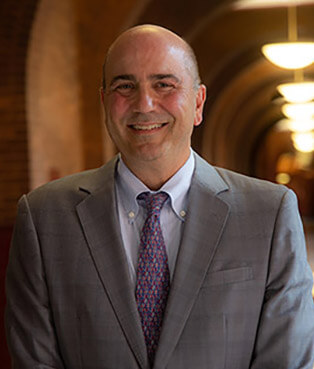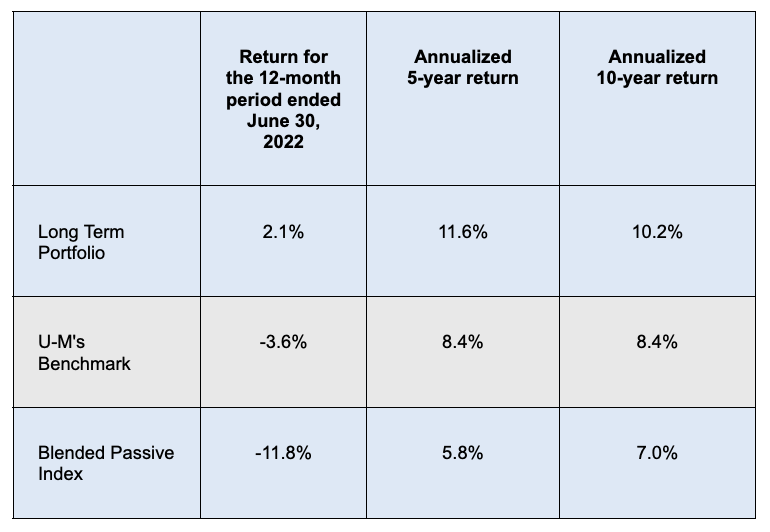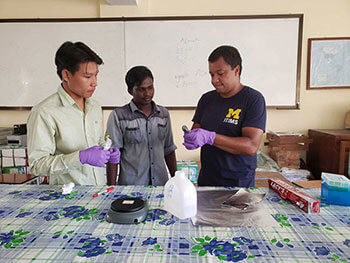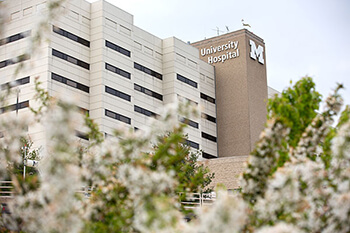Chief Financial Officer's Report

The University of Michigan has been regarded as a global leader in higher education for generations. While there are many reasons for this well-deserved reputation, two notable factors stand out — U-M’s exceptionally strong and longstanding financial strength as well as the continued focus of our 50,000+ employees on the institution’s missions of education, research and patient care.
FY 2022 presented a number of challenges, including continuation of the COVID-19 pandemic, supply chain disruptions and the onset of inflation. Despite these challenges, U-M continued to provide an outstanding education to students from around the world, perform important research that benefits society and provide exceptional health care services. The university also continued its proactive focus on building a strong foundation — financial and otherwise — to ensure it can best serve its students, patients and society in the years ahead.
MAINTAINING A STRONG FINANCIAL POSITION
The university’s financial position remains very strong with a net position of $19.3 billion at June 30, 2022. U-M’s FY 2022 net investment income of $336 million was among the highest for universities with large endowments, with most reporting losses after extraordinary gains the prior year. In addition, the increase in year-over-year operating expenses reflects costs associated with finalization of a settlement agreement between the university and claimants who alleged abuse by the late physician Robert Anderson. Operating expenses in FY 2022 also reflect the lifting of most pandemic-related spending restrictions, a rebound in campus activities and inflation.
To take advantage of historically low interest rates and lock in a semi-permanent source of capital, the university issued $2.5 billion of general revenue bonds during FY 2022. This included $1.7 billion of century bonds — the largest ever issued in higher education — and $300 million of green bonds, both firsts for the university. Total bond proceeds were utilized to refund $69 million of existing bonds, establish an escrow of $412 million to advance refund existing bonds as well as provide $1.7 billion for capital projects and general purposes along with $299 million for capital projects designed to advance the university’s commitment to decarbonization.
Our endowment distribution policy and long-term investment strategy combine to insulate U-M from volatility and provide dependable annual support for operations. The endowment distribution policy smooths the impact of capital market volatility by providing for annual distributions of 4.5 percent of the seven-year moving average fair value of the University Endowment Fund. This policy, along with the endowment’s growth, allowed for distributions of $434 million to support university operations in FY 2022, for a total of $1.9 billion over the past five years. Distributions from more than 12,400 individual endowments provide ongoing and dependable support for a variety of academic, health-related and other needs across the university such as student scholarships, professorships, clinical operations and research.
Endowment funds, which are invested principally in the university’s Long Term Portfolio, totaled $17.3 billion at June 30, 2022. The table below summarizes the investment performance of U-M’s Long Term Portfolio in relation to comparative benchmark portfolio returns.
INVESTMENT PERFORMANCE

DIVERSIFICATION IN REVENUE STREAMS
U-M has a diversified revenue base, which has enabled the university to remain financially stable through various economic cycles and challenges as well as avoid unnecessary dependence on student tuition and fee increases. The components of the university’s sources of revenue are depicted below.
Funding from the state of Michigan continues to be an essential source of financial support for U-M. In FY 2022, state educational appropriations totaled $392 million. We are very appreciative of the ongoing support of higher education and U-M by residents of the state, particularly in a year that saw inflation and ongoing economic issues due to the COVID-19 pandemic.
U-M’s operating budget continues to balance academic excellence and investment in the future with student affordability and access. For the Ann Arbor campus, tuition rate increases for FY 2022 were 1.4 percent for in-state undergraduate students and 1.8 percent for nonresident undergraduate students and most graduate students. For the Dearborn campus, tuition rate increases for undergraduate and graduate students were 1.9 percent and for the Flint campus, there was no increase in undergraduate rates and a 3 percent increase for graduate students.
The FY 2022 budget also included a 6.4 percent increase in financial aid for undergraduates on the Ann Arbor campus as well as an extension of the Go Blue Guarantee to the Dearborn and Flint campuses. This landmark program provides four years of free tuition for high-achieving in-state undergraduate students with a family income of $65,000 or less and assets less than $50,000. U-M has been able to limit tuition increases and provide generous financial aid because of continued growth in non-tuition revenues and a longstanding commitment to controlling costs and improving efficiencies across its operations.
Demand for a U-M education continues to grow. More than 90,000 prospective first-year-student applications — a record number — were submitted from around the world for the university’s three campuses. This is the 15th consecutive year that applications have increased. U-M’s impressive global reputation and incredible value make it a top destination for outstanding students from Michigan, the United States and countries around the world.
U-M RESEARCH ADDRESSES SOCIETAL CHALLENGES AND DRIVES ECONOMIC GROWTH

Researchers throughout the university secured nearly 3,000 new awards from external sponsors during FY 2022 and the total value of those research awards increased 14.7 percent when compared to FY 2021. This type of support has allowed U-M teams to utilize their knowledge and experience to address key societal challenges that impact communities across Michigan and beyond — from Great Lakes water quality and substance abuse to youth violence and global health disparities.
With a record $1.7 billion volume of research expenditures in FY 2022, U-M made key advances in many important and wide-ranging areas, from driverless vehicle technologies to treatments for serious medical conditions. U-M’s research efforts continue to have a significant and positive impact on a global level.
The federal government continues to be a leading sponsor of U-M research and scholarship activity. More than half of the university’s total research expenditures were supported by federal agencies, totaling $973 million in FY 2022, an 8.9 percent increase when compared to FY 2021.
As a public research university, U-M remains committed to ensuring that research discoveries are translated from its laboratories to the marketplace in ways that benefit society and drive economic growth. During FY 2022, U-M research led to 16 startups and 433 new inventions.
MICHIGAN MEDICINE CONTINUES TO BE A LEADER IN HEALTH CARE

Michigan Medicine — which includes University of Michigan Health (UMH), University of Michigan Medical School, Michigan Health Corporation and UM-Health — is acknowledged across the country as a leader in advanced patient care, innovative research to improve human health and comprehensive education of physicians and medical scientists.
Despite challenges from the COVID-19 omicron surge, supply chain issues and workforce shortages, UMH realized positive financial results in FY 2022, with a 1.9 percent — or $94 million — operating margin on operating revenues of $5.0 billion. UMH also recognized federal pandemic relief funding of $30 million.
Dedication, talent and commitment to the highest standards of patient care along with a focus on inclusion and teamwork enabled Michigan Medicine to successfully manage ongoing COVID-19 issues and introduce new initiatives to improve access. These initiatives include the Care at Home program, which offers patients hospital-level care combined with the opportunity to recover at home. This program provides eligible patients with the option to receive nurse and physician visits — plus a wide array of tests, treatments and monitoring — in their homes. That allows some hospitalized patients to return home sooner to receive care in familiar surroundings, closer to loved ones.
In addition, construction of The Pavilion at University of Michigan Health continues. When completed, this new 12-story adult inpatient hospital will house 264 private rooms capable of converting to intensive care, a state-of-the-art neurological and neurosurgical center, high-level specialty care services for cardiovascular and thoracic patients and advanced imaging services. The 690,000-gross-square-foot building is expected to open in fall 2025.
Planning is also underway for a major expansion into specialty and mail pharmacy services from a new facility near Ann Arbor. The expansion will allow Michigan Medicine to more than double the number of prescriptions it fills each year through its existing in-house pharmacy.
LOOKING AHEAD
The University of Michigan continues to be financially strong and is well positioned for the future. We are one of only seven public universities in the country to earn the highest possible credit ratings from S&P Global (AAA) and Moody’s (Aaa). The university has maintained these outstanding ratings for years, and they’re a clear indication of our long-term financial strength and stability.
As part of its ongoing effort to maintain excellence in education, research and patient care as well as offer collaboration opportunities for multiple disciplines, the university continues to make important capital investments in a wide array of its facilities.
An overview of the capital projects completed, in progress and in planning during FY 2022 appears in the Major Projects section. Our long-time approach of balancing investments in new facilities against the renewal of existing facilities enables us to avoid an excessive accumulation of deferred facility maintenance.
Please take some time to review Management’s Discussion and Analysis (PDF) in conjunction with the audited financial statements. In this section of the annual report, you’ll find more details about the university’s financial strength, prudent financial policies and commitment to excellence. These factors — in conjunction with the ongoing efforts of our outstanding employees — enable U-M to continue its longstanding commitment to improving society through world-class education, research and patient care.
Sincerely,

Geoffrey S. Chatas
Executive Vice President and Chief Financial Officer
